What to Do When You Inherit a Retirement Account
Inheriting a retirement account—whether it’s an IRA, Roth IRA, or 401(k)—often comes with mixed emotions. It can be a generous gift, the result of decades of saving and planning by a loved one. But without a clear understanding of how one inherits these accounts, it can also turn into a tax headache.
Change is In the Air
Over the last few years, big legislative changes have reshaped the way retirement accounts are passed down to heirs. The SECURE Act of 2019 and its follow-up, SECURE 2.0, altered the landscape for beneficiaries, limiting long-favored strategies and replacing them with tighter withdrawal windows, like the 10-Year Rule.
These changes mean that what once felt like a generous, tax-friendly inheritance now requires careful planning to avoid turning into a tax burden. If you’ve inherited a retirement account—or plan to leave one behind—it's more important than ever to understand the new rules of the game.
I’ve put together a number of steps that help you decide what to do with your inherited retirement account and how to proceed.
🧾 Step 1: Know What Type of Account You’ve Inherited
The first thing to understand is what kind of account you’ve inherited. Was it a Traditional IRA? A Roth IRA? A 401(k)? Each type has different tax rules attached.
Traditional accounts (like IRAs or 401(k)s) were funded with pre-tax dollars, so any distributions you take are fully taxable as ordinary income.
Roth accounts were funded with after-tax dollars. Withdrawals are generally tax-free, but they may still be subject to required distribution rules.
The type of account will impact how and when you take money from it—and what the tax consequences will be.
👥 Step 2: Know Your Relationship to the Original Owner
Your options depend greatly on your relationship to the deceased.
Spouses have the most flexibility. They can treat the account as their own, roll it into their own IRA, or remain as the beneficiary.
Non-spouse beneficiaries (like adult children, siblings, or friends) typically cannot roll the account into their own name. Instead, they must open an inherited IRA and follow specific distribution rules.
Knowing where you fall will guide everything else.
⏳Step 3: Understand the SECURE Act, the 10-Year Rule—and the New RMD Requirements
One of the biggest changes to inherited retirement accounts came with the SECURE Act of 2019, and SECURE 2.0 added further complexity. For most non-spouse beneficiaries, the law now requires that the entire balance of the inherited account be withdrawn within 10 years of the original owner’s death. This is what’s known as the “10-Year Rule.”
But here’s what many people miss: If you inherit a pre-tax retirement account (like a Traditional IRA) and the original account owner had reached their Required Minimum Distribution (RMD) age prior to their passing, the IRS requires beneficiaries to take Required Minimum Distributions (RMDs) in years 1 through 9—not just a full liquidation by year 10. This means you can’t simply wait until the final year to take a lump sum. Skipping RMDs when they’re required can result in hefty penalties. This does not apply to Roth IRAs.
These rules apply to most non-spouse heirs, including adult children. However, there are exceptions:
Minor children (until they reach the age of majority)
Chronically ill or disabled individuals
Beneficiaries less than 10 years younger than the deceased
If you fall into one of these categories, you may still be able to take distributions over your lifetime instead of following the 10-Year Rule.
But for most beneficiaries, the clock starts ticking the year after the original account holder’s death—and the IRS will expect to see distributions along the way.
💡 Step 4: Be Strategic About Withdrawals
One of the biggest mistakes people make is ignoring the tax consequences until it’s too late.
Let’s say you inherit a $500,000 Traditional IRA and wait until year 10 to take it all out. That full $500,000 could be added to your taxable income in a single year, potentially pushing you into the highest tax brackets.
Instead, consider taking smaller, controlled distributions over multiple years. If you’re still working, maybe you take more in years you expect a lower income. Or if you’ve recently retired, you might use this time before Social Security or Required Minimum Distributions kick in to take advantage of low tax brackets.
🛑 Step 5: Handle Roth IRAs with Care
Roth IRAs are a bit different—and people often assume they’re tax-free in all situations. Yes, withdrawals from Roth IRAs are generally tax-free, but they’re still subject to the 10-Year Rule if you’re a non-spouse beneficiary.
That means even though you’re not taxed on the distributions, you can’t leave the money in there forever. Letting it sit for the full 10 years might make sense for growth potential—but you must be sure to empty the account by the end of that window.
🧠 Step 6: Don’t Make Any Quick Moves Without Advice
Cashing out an inherited account, rolling it into the wrong type of account, or missing key deadlines can result in irreversible tax consequences or penalties.
Before taking action, talk to a financial planner and/or tax professional who understands inherited IRA rules. With the right strategy, you can:
Minimize your tax burden
Align the inheritance with your own financial goals
Avoid common pitfalls
✍️ My Final Thoughts: Inheritance Is an Opportunity—Handle It Wisely
Inheriting a retirement account can feel overwhelming. You’re dealing with loss, paperwork, and unfamiliar rules. But handled wisely, it’s a powerful financial opportunity.
If you or someone you know is navigating the inheritance of an IRA or 401(k), and you're unsure how to proceed, I'd be happy to help point you in the right direction.




